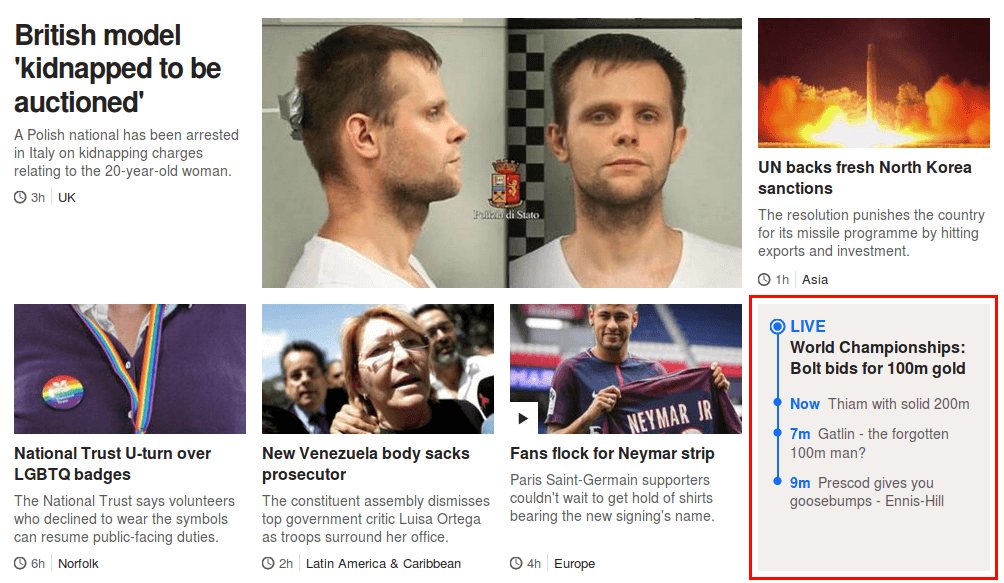TL;DR
- Second is a framework for building React applications where the data is fetched on the server and most of the components do not change after the first render.
- Components can declare their data dependencies using a container similar to Facebook’s Relay.
- By default components are only rendered on the server; client-side rendering is opt-in by using the component dehydrator.
- Second works with any React-like library including Preact.
Why build this framework?
While using React to build the BBC News front page and several other mostly-static pages, a common theme emerged: only a small number of components on these pages require client-side JavaScript to function. Rendering every component in the browser does not provide an optimal experience — especially for users on low-powered devices or low-speed connections. Instead, selectively bundling components for the browser reduces bundle sizes and minimizes CPU overhead without sacrificing React’s event system and stateful components.
Second is not a large or complex framework. It is the result of combining several simple and well-tested techniques—
- Server-side rendering
- Container components for declarative data requirements
- Selective client-side rendering
—and combining them into a single package that can be easily reused across multiple applications.
How does it work?
Server-side rendering
At its simplest, Second is just a wrapper around server-side rendering:
import VDom from 'react'
import VDomServer from 'react-dom/server'
import second from 'second'
import MyComponent from './components/my-component'
second.init({ VDom, VDomServer })
const props = {
// ...
}
second.render(MyComponent, props).then((result) => {
console.log('Rendered HTML:', result)
})
Data-driven components
second-container is a higher-order container component inspired by Facebook’s Relay that allows components to declare their data requirements. Unlike Relay which works only with GraphQL, second-container works with regular HTTP requests out of the box and supports custom data fetchers as well.
const ComponentWithData = second.createContainer(MyComponent, {
data: (props) => ({
// Each key is provided to the wrapped component as a prop
queryResponse: {
// Props can be used to dynamically build API endpoints
uri: `http://api.duckduckgo.com/?q=${props.query}&format=json`
},
events: {
// Requests can be marked as optional to avoid failing
// the entire render when one request fails
mustSucceed: false,
uri: `https://api.github.com/users/${props.username}/events`
}
})
})
Containers can be used at any level of the render tree, allowing leaf nodes to fetch their own data. For static render trees, this typically scales better than fetching data at the root and passing it as a prop down through the entire tree.
Second’s renderer integrates seamlessly with the containers. By keeping track of outgoing requests, it ensures every mandatory request has returned successfully before fulfilling the rendered tree.
Partial, opt-in browser rendering
second-dehydrator is a higher-order component that serialises (“dehydrates”) a component’s props and renders them into an inline <script> tag. The component can then be hydrated in the browser with its original props, and rendered as a regular interactive React component.
Take this “top stories” BBC News component, for example. It is static except for the live-updating promo in the bottom-right corner.

This component can be bundled efficiently by dehydrating just the live promo:
import { createDehydrator } from 'second-dehydrator'
import StaticPromo from './components/static-promo'
import LivePromo from './components/live-promo'
const dehydrate = createDehydrator(React.createElement)
const DehydratedLivePromo = dehydrate(LivePromo)
const TopStories = (props) =>
<div className="nw-c-top-stories">
<StaticPromo item={props.items[0]} />
<StaticPromo item={props.items[1]} />
<StaticPromo item={props.items[2]} />
<StaticPromo item={props.items[3]} />
<StaticPromo item={props.items[4]} />
<DehydratedLivePromo item={props.items[5]} />
</div>
To hydrate this component in the browser, second-dehydrator takes a component map and a callback. The hydrator scans the DOM for dehydrated components and their corresponding props. It hydrates each component with its props and passes them to the callback function, where they can be rendered with React.
import React from 'react'
import ReactDOM from 'react-dom'
import { hydrate } from 'second-dehydrator'
const renderComponent = (HydratedComponent, props, containerElement) => {
ReactDOM.render(
React.createElement(HydratedComponent, props),
containerElement
)
}
const componentMap = {
LivePromo: () => import(/* webpackMode: "eager" */ './components/live-promo')
}
hydrate(renderComponent, componentMap)
What next?
Second has worked well for some of the projects that I’ve worked on this year. These projects have mostly been content-driven pages, with a couple of interactive form-based applications. I’d like to use Second in a wider range of projects to get a feel for whether the abstractions are at the right level and whether the APIs are flexible enough.
By opening up the framework, I’m hoping that the wider React community can have some discussions about whether selective client-side rendering is a useful pattern, and if it is, whether a framework like Second is the right way to implement the pattern.
